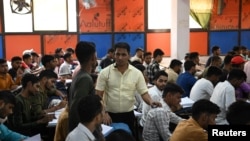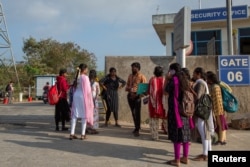The government in India will spend $24 billion on boosting employment opportunities for young people, as job creation emerges as the biggest challenge confronting Prime Minister Narendra Modi in his third term.
The government also announced financial support for development projects in two states ruled by its regional allies.
Modi’s Bharatiya Janata Party failed to win a clear majority in recent elections and has formed a coalition government. Although the country’s economy is growing briskly, high unemployment and distress in its vast rural areas were cited as the key reasons for the party’s loss of support.
Presenting the annual budget in parliament on Tuesday, Finance Minister Nirmala Sitharaman said the government will "facilitate employment, skilling and other opportunities" for more than 40 million young people over the next five years.
She said the government will provide paid internships in the country’s 500 top companies to improve opportunities for job seekers.
India posted 8.2% growth last year, the fastest among major economies in the world. But critics say only some have benefitted from the boom, while millions struggle to earn a livelihood.
The government’s announcement that it will raise spending on loans for small and medium-sized businesses to boost job creation was welcomed by several economists. Opposition parties have long criticized the Modi government for giving billions of dollars in subsidies to big business and not extending enough assistance to smaller ones.
“The support to smaller businesses is critical because these are the enterprises which create jobs. Big corporations on the other hand use capital intensive technologies, which don’t result in any significant employment generation,” economist Santosh Mehrotra told VOA. “The government appears to have taken serious note of the jobless crisis we face for the first time in 10 years since it has been in power.”
He said providing internships could be a crucial step in tackling the unemployment problem. Mehrotra said it remains to be seen how the proposals are implemented.
Economists say jobs have failed to grow because India’s manufacturing sector is relatively small, accounting for only 17% of gross domestic product.
According to official figures, the unemployment rate is close to 6%, but an economic research group, the Center for Monitoring Indian Economy, estimates that it is about 9%. The biggest challenge confronts young graduates, among whom the unemployment rate is about 29%. In the world’s youngest country, an estimated 10 million people enter the workforce every year.
A World Bank report released in April, “Jobs for Resilience,” said that while growth in South Asian countries like India is strong, the region is not creating enough jobs to keep pace with its rapidly increasing working-age population. According to the report, the employment ratio for South Asia was 59%, compared to 70% in other emerging market and developing economy regions.
India’s economy will continue expanding at a brisk pace, according to government estimates, which have pegged growth this year at 6.5% to 7% – lower than that posted last year but still high among major economies.
"The global economy, while performing better than expected, is still in the grip of policy uncertainties," she said. "In this context, India's economic growth continues to be the shining exception and will remain so in the years ahead," Finance Minister Sitharaman said.
Modi said the budget will lead India toward “better growth and a bright future.”
With an eye on keeping its coalition allies on board, the government also announced financial assistance for two states — Andhra Pradesh and Bihar. The two regional parties that govern these states have pledged support to Modi and are crucial for his BJP to stay in power.








